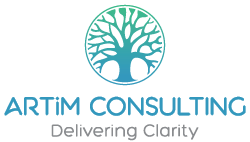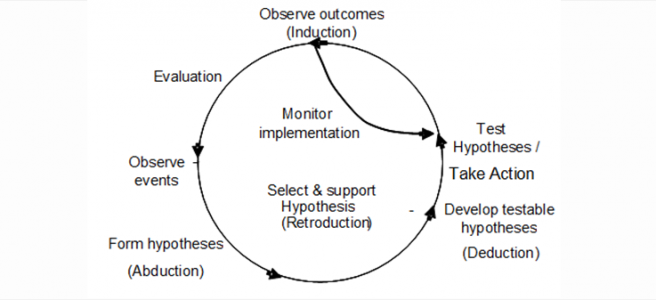In the last few weeks we have identified three critical aspects of organisational learning: that it should be an iterative process to support our increasingly robust understanding of the situation, that it should support not only intuition but rigorous explanatory reasoning and that it should enable different forms of learning. We’ve looked at the Lewin, Kotter, ADKAR and PDCA models and then at DMAIC and Design Thinking. The conclusion thus far has been that none of these models or frameworks support all the three learning requirements. In this post we consider a framework that might.
The Logic for Scientific Inquiry (LOSI) owes its origin to a number of sources. One source is Emery Trist’s Open Systems Theory. Every organisation is embedded in an external environment. The organisation influences and is influenced by the environment in ways that are hard to predict. The combination of the organisation and its environment co-evolve over time. The question then is how we can make choices about what internal and external factors to include when we try to predict outcomes of our actions. Do we need to consider a butterfly flapping its wings in the Amazon?
This leads us to the second source, an American philosopher, Charles Peirce. His ‘pragmatist maxim’ allows us to limit our consideration to only those effects that we think are relevant, which most likely lets us ignore the Amazonian butterfly. But it doesn’t give us a prescription for what to include in our consideration. What we must do is put together a framework for thinking about the situation that leads us to a hypothesis about the cause of the problem. What it does recognise is that we can never know in advance what we must consider. For that we must rely on experimentation.
And that leads us to the third source, Kolb’s experiential learning cycle, which is based on the recognition that our knowledge at any point in time is limited and we must take action, observe and learn as we engage in an iterative learning process, adding to our store of knowledge as we go. We can put these contributions together into a single iterative process that goes something like this.
A person notices an issue and something needs to be done about it. If this person is interested in understanding the world, i.e. is a scientist, they might have noticed something that current theory doesn’t explain. Peirce called this the ‘irritation of doubt’. If the person is an agent for change in an organisation, they may have noticed a situation that is problem or presents an opportunity for improvement. Since we are talking about organisational change let’s say the problem is that employees are reporting a lack of engagement with their work. The agent for change, Jane, puts together a group of people from Finance and Sales to see what can be done.
The group puts together what they know about the situation into a conceptual framework, a theory that explains why the situation has come to be. In this example, the framework might be a model for employee engagement. They then looks within this framework for an explanation for the situation. The problem, as stated, is that employees in Finance need to work more closely with Sales to be able to respond faster to requests from prospects for cost estimates. The group uses an alignment model to explore the issue and concludes that people are unable to collaborate for various reasons: the way the office is laid out, the way salespersons are incentivised and so on. There is lack of alignment between the targeted turnaround for cost estimates and organisational structure, processes, reward systems etc.
The group comes with a set of change initiatives and then compares the alternatives to pick one that they conclude, based on their conceptual framework, will produce a result that most closely matches the desired result. The group makes the intervention, observing closely what happens, recording observations for analysis. When the intervention is over, the group checks to see how far they come in addressing the issue. If the issue persists or has evolved into a different issue, the group reflects on the observation to see what changes to make in their conceptual framework to explain the new situation.
The group then repeats the cycle and makes another intervention, continuing till the issue is resolved or has been reduced to insignificance. This iterative process, the Logic of Scientific Inquiry or LOSI, provides a sound basis for Action Research, an intervention based approach to organisational change.
So how does this framework for change meet the three organisational learning requirements? The approach looks a lot like Design Thinking. Both are iterative and with both approaches the issue or opportunity can evolve through the iterations. But there is a crucial difference, which we will look at next week.
If you are interested in learning more about organisational alignment, how misalignment can arise and what you can do about it join the community. Along the way, I’ll share some tools and frameworks that might help you improve alignment in your organisation

